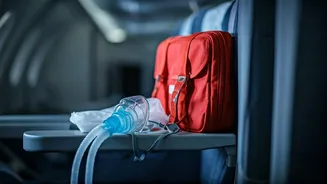Emergency Unfolds Mid-Air
The serene atmosphere of a flight cruising towards Saudi Arabia was abruptly disrupted by a passenger's sudden loss of consciousness. The unfortunate event
swiftly triggered the established protocols for in-flight medical emergencies. The flight crew immediately sprang into action, assessing the situation and swiftly determining the need for urgent medical assistance. The priority was the passenger's health, leading to a critical decision that would alter the aircraft's course and destination. The nature of the medical issue prompted the captain and crew to consider the most suitable and immediate action available to ensure the passenger's well-being. This was a challenging situation that required immediate decision making and precision on the crew's part.
Diversion to Thiruvananthapuram
With a passenger's health hanging in the balance, the flight crew made the pivotal decision to divert the aircraft. The chosen destination was Thiruvananthapuram, a city in India, signaling the start of a new chapter in the journey. This decision was based on factors such as the availability of medical facilities and the proximity to the aircraft's current location, taking into account the urgency of the passenger's condition. The decision, though unexpected, demonstrated the crew's commitment to adhering to safety regulations and their responsibility towards the passenger. A landing in Thiruvananthapuram not only provided access to emergency medical resources but also streamlined the rescue process, thus prioritizing the passenger's survival.
Rapid Response Protocol
The incident highlighted the crucial role of standardized emergency procedures in air travel. From the first signs of the medical emergency, the flight crew activated their well-honed protocols, initiating communication with air traffic control. The crew's training and swift execution of emergency procedures minimized any potential dangers, as medical personnel and other resources were rapidly mobilized. The emergency protocol covers various scenarios to ensure the safety and health of all passengers, demonstrating the industry's commitment to safety and preparedness. The speed with which emergency services and medical professionals were on standby upon landing showcased the effectiveness of coordination and collaboration between the crew and ground-based support.
Focus on Passenger Care
Upon arrival in Thiruvananthapuram, the focus immediately shifted to the affected passenger's well-being. The aircraft touched down and the crew members assisted in facilitating the quick transfer of the passenger to appropriate medical care. Medical professionals were waiting, ready to provide immediate attention. Every decision and action was geared towards ensuring a positive health outcome. The entire event underscored the critical importance of a coordinated response, with various stakeholders such as the flight crew, ground staff, and medical teams working in tandem to support the passenger. The care offered during this emergency illustrated the aviation industry's deep commitment to the welfare of passengers and the importance of having the right resources for critical situations.
Airline's Preparedness & Protocols
The events demonstrated the efficiency of the airline's preparedness and protocols when handling unforeseen medical emergencies. The training the crew had received to manage such situations clearly showed its effectiveness as they applied the necessary steps to deal with the medical crisis. From the flight's diversion to its safe landing at Thiruvananthapuram, every stage of the emergency response demonstrated the airline's rigorous adherence to safety measures and the high standards maintained within aviation. The rapid coordination with ground personnel and the availability of medical support underscore the meticulous planning that goes into ensuring passenger safety. This emergency response provides a clear example of the company's commitment to safety.

















